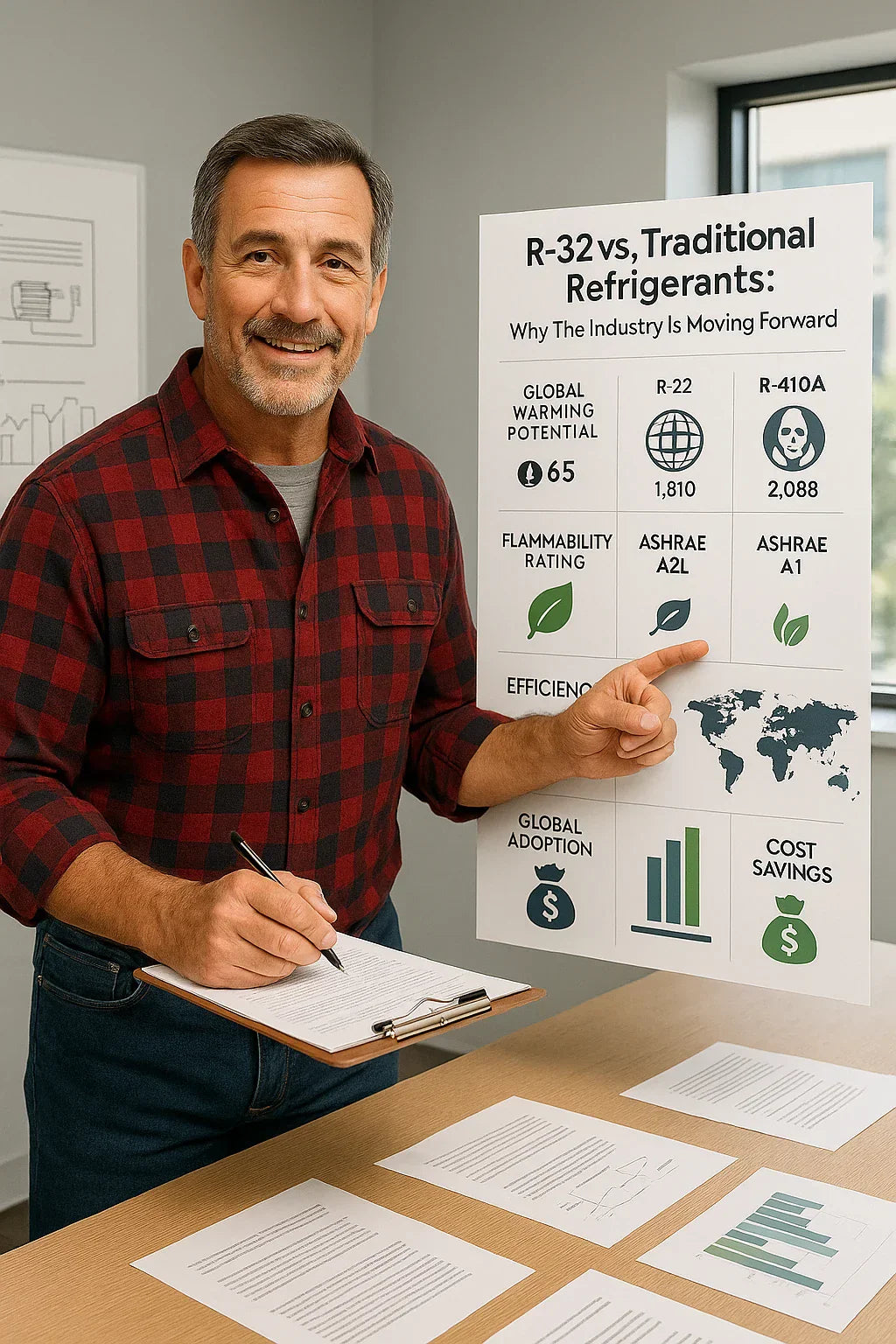🚀 Introduction: The Refrigerant Revolution Is Already Here
“If you're buying a new furnace or heat pump today, you can't ignore the refrigerant that's inside. It’s like buying a car without knowing if it runs on gas or electricity.”
The transition to R-32 isn’t just a manufacturer’s choice — it's driven by environmental policy, global agreements, and advanced HVAC technology. In this guide, we compare R-32 head-to-head with legacy refrigerants like R-410A and R-22, and explain why it’s quickly becoming the standard in 2025 and beyond.
🌍 Section 1: The Global Push — Why Refrigerant Choice Matters
-
The Kigali Amendment: Global phasedown of HFCs under the Montreal Protocol
-
U.S. AIM Act 2020: Mandates 85% HFC reduction by 2036
-
State-level bans: California, New York, and others accelerating phaseouts
🔬 Result: HVAC manufacturers are proactively switching refrigerant lines ahead of deadlines.
🔗 United Nations Kigali Amendment Summary
⚗️ Section 2: R-22, R-410A, and R-32 — Chemical Comparison
| Property | R-22 (HCFC) | R-410A (HFC Blend) | R-32 (HFC Single) |
|---|---|---|---|
| Status | Fully banned | Phaseout active | New adoption (2025+) |
| Global Warming Potential (GWP) | 1,810 | 2,088 | 675 |
| Ozone Depletion Potential (ODP) | 0.055 | 0 | 0 |
| Flammability Class (ASHRAE) | A1 | A1 | A2L |
| Pressure Behavior | Low | High | Higher |
Key takeaway:
R-32 dramatically lowers climate impact while offering higher efficiency than both R-22 and R-410A.
🔗 ASHRAE Refrigerant Safety Classifications
🔬 Section 3: What Makes R-32 More Efficient?
-
Higher heat transfer coefficient = faster cooling/heating cycles
-
Lower charge volume = smaller refrigerant mass needed
-
Better pressure stability = improved compressor longevity
-
Reduced pumping losses = smaller compressor draw, lower kWh usage
“Think of it like this: R-32 is like switching from 87-octane gas to premium — more power with less fuel burned.”
🔗 Daikin R-32 Efficiency Analysis
🧯 Section 4: What About Flammability? The A2L Debate Explained
-
R-32 is mildly flammable (A2L) — but requires specific ignition concentration, temperature, and spark energy
-
Real-world safety data:
-
UL 60335-2-40 certifies R-32 systems
-
No widespread incidents reported in residential field use globally
-
-
Leak detection, ventilation safeguards, sealed compressors all mitigate risk
🔗 UL R-32 Residential HVAC Safety Standard
🧭 Section 5: Who Has Already Adopted R-32?
-
Japan (95% market share since 2013)
-
Europe (widespread adoption since 2015)
-
Australia, New Zealand, Middle East (growing deployment)
In the U.S., 2024-2025 represents the largest surge of R-32 adoption across:
-
Heat pumps
-
Gas furnace hybrid systems
-
Through-the-wall packaged AC units
🔗 IEA Global Refrigerant Transition Status
🏠 Section 6: How R-32 Impacts Home Furnace Installations
✅ Benefits for homeowners:
-
Higher efficiency ratings (SEER2, HSPF2)
-
Smaller outdoor units
-
Lower energy bills
-
Fewer long-term refrigerant phaseout concerns
🚧 Considerations:
-
Certified R-32 installers required
-
New refrigerant handling protocols
-
May require full coil and line set replacements when upgrading
“Buy it right now, and you’re buying a future-proof system that won’t need another refrigerant switch for decades.”
🔗DOE High Efficiency Heating & Cooling Guide
📑 Section 7: Environmental Impact — The Big Picture
| Metric | R-410A | R-32 |
|---|---|---|
| Full lifecycle emissions (CO₂e) | High | 70% lower |
| Energy consumption | Higher | Lower |
| Service recyclability | Difficult | Easy (single component) |
R-32 reduces lifetime emissions by combining lower direct impact (GWP) with indirect energy savings.
🔗IPCC Sixth Assessment Report - Climate Metrics
🏷️ Section 8: Cost Comparison — Does R-32 Save You Money?
| Cost Category | R-410A Legacy System | R-32 System |
|---|---|---|
| Equipment MSRP | $2,500–$4,000 | $3,000–$5,000 |
| Installation | $1,500–$3,500 | $2,000–$4,000 |
| Annual Operation (energy) | $1,400 | $1,100 |
| Refrigerant service | More complex | Simplified (single gas) |
✅ Within 5–7 years, most homeowners recoup upfront premium through lower utility bills and service savings.
✅ Mike’s Final Take:
“R-32’s like the hybrid pickup of refrigerants: more efficient, easier to maintain, cleaner for the planet, and still built tough. You’ll wonder why we didn’t switch years ago.”
📎 See Our Full R-32 Furnace Lineup → Shop 80,000 BTU R-32 Gas Furnaces
In the next article we will know about: How to Maintain an R-32 Gas Furnace for Maximum Lifespan & Efficiency







